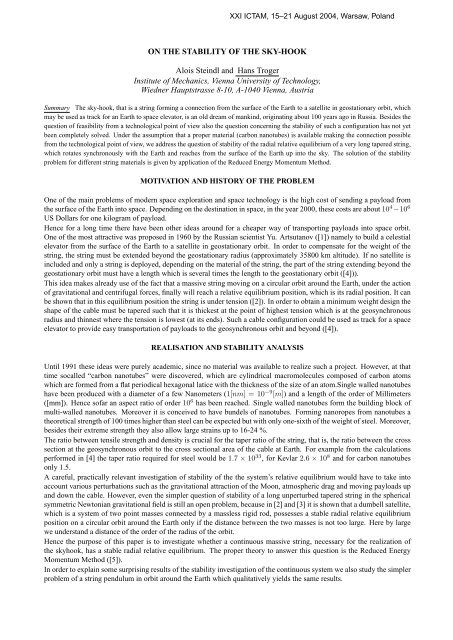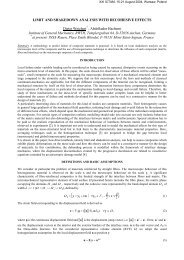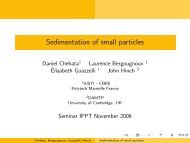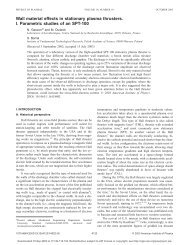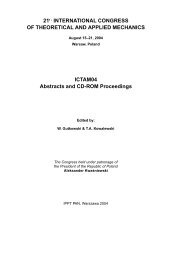ON THE STABILITY OF THE SKY-HOOK Alois Steindl and Hans ...
ON THE STABILITY OF THE SKY-HOOK Alois Steindl and Hans ...
ON THE STABILITY OF THE SKY-HOOK Alois Steindl and Hans ...
Create successful ePaper yourself
Turn your PDF publications into a flip-book with our unique Google optimized e-Paper software.
<strong>ON</strong> <strong>THE</strong> <strong>STABILITY</strong> <strong>OF</strong> <strong>THE</strong> <strong>SKY</strong>-<strong>HOOK</strong><br />
XXI ICTAM, 15–21 August 2004, Warsaw, Pol<strong>and</strong><br />
<strong>Alois</strong> <strong>Steindl</strong> <strong>and</strong> <strong>Hans</strong> Troger<br />
Institute of Mechanics, Vienna University of Technology,<br />
Wiedner Hauptstrasse 8-10, A-1040 Vienna, Austria<br />
Summary The sky-hook, that is a string forming a connection from the surface of the Earth to a satellite in geostationary orbit, which<br />
may be used as track for an Earth to space elevator, is an old dream of mankind, originating about 100 years ago in Russia. Besides the<br />
question of feasibility from a technological point of view also the question concerning the stability of such a configuration has not yet<br />
been completely solved. Under the assumption that a proper material (carbon nanotubes) is available making the connection possible<br />
from the technological point of view, we address the question of stability of the radial relative equilibrium of a very long tapered string,<br />
which rotates synchronously with the Earth <strong>and</strong> reaches from the surface of the Earth up into the sky. The solution of the stability<br />
problem for different string materials is given by application of the Reduced Energy Momentum Method.<br />
MOTIVATI<strong>ON</strong> AND HISTORY <strong>OF</strong> <strong>THE</strong> PROBLEM<br />
One of the main problems of modern space exploration <strong>and</strong> space technology is the high cost of sending a payload from<br />
the surface of the Earth into space. Depending on the destination in space, in the year 2000, these costs are about 10 4 −10 6<br />
US Dollars for one kilogram of payload.<br />
Hence for a long time there have been other ideas around for a cheaper way of transporting payloads into space orbit.<br />
One of the most attractive was proposed in 1960 by the Russian scientist Yu. Artsutanov ([1]) namely to build a celestial<br />
elevator from the surface of the Earth to a satellite in geostationary orbit. In order to compensate for the weight of the<br />
string, the string must be extended beyond the geostationary radius (approximately 35800 km altitude). If no satellite is<br />
included <strong>and</strong> only a string is deployed, depending on the material of the string, the part of the string extending beyond the<br />
geostationary orbit must have a length which is several times the length to the geostationary orbit ([4])).<br />
This idea makes already use of the fact that a massive string moving on a circular orbit around the Earth, under the action<br />
of gravitational <strong>and</strong> centrifugal forces, finally will reach a relative equilibrium position, which is its radial position. It can<br />
be shown that in this equilibrium position the string is under tension ([2]). In order to obtain a minimum weight design the<br />
shape of the cable must be tapered such that it is thickest at the point of highest tension which is at the geosynchronous<br />
radius <strong>and</strong> thinnest where the tension is lowest (at its ends). Such a cable configuration could be used as track for a space<br />
elevator to provide easy transportation of payloads to the geosynchronous orbit <strong>and</strong> beyond ([4]).<br />
REALISATI<strong>ON</strong> AND <strong>STABILITY</strong> ANALYSIS<br />
Until 1991 these ideas were purely academic, since no material was available to realize such a project. However, at that<br />
time socalled “carbon nanotubes” were discovered, which are cylindrical macromolecules composed of carbon atoms<br />
which are formed from a flat periodical hexagonal latice with the thickness of the size of an atom.Single walled nanotubes<br />
have been produced with a diameter of a few Nanometers (1[nm] = 10 −9 [m]) <strong>and</strong> a length of the order of Millimeters<br />
([mm]). Hence sofar an aspect ratio of order 10 6 has been reached. Single walled nanotubes form the building block of<br />
multi-walled nanotubes. Moreover it is conceived to have bundels of nanotubes. Forming nanoropes from nanotubes a<br />
theoretical strength of 100 times higher than steel can be expected but with only one-sixth of the weight of steel. Moreover,<br />
besides their extreme strength they also allow large strains up to 16-24 %.<br />
The ratio between tensile strength <strong>and</strong> density is crucial for the taper ratio of the string, that is, the ratio between the cross<br />
section at the geosynchronous orbit to the cross sectional area of the cable at Earth. For example from the calculations<br />
performed in [4] the taper ratio required for steel would be 1.7 × 10 33 , for Kevlar 2.6 × 10 8 <strong>and</strong> for carbon nanotubes<br />
only 1.5.<br />
A careful, practically relevant investigation of stability of the the system’s relative equilibrium would have to take into<br />
account various perturbations such as the gravitational attraction of the Moon, atmospheric drag <strong>and</strong> moving payloads up<br />
<strong>and</strong> down the cable. However, even the simpler question of stability of a long unperturbed tapered string in the spherical<br />
symmetric Newtonian gravitational field is still an open problem, because in [2] <strong>and</strong> [3] it is shown that a dumbell satellite,<br />
which is a system of two point masses connected by a massless rigid rod, possesses a stable radial relative equilibrium<br />
position on a circular orbit around the Earth only if the distance between the two masses is not too large. Here by large<br />
we underst<strong>and</strong> a distance of the order of the radius of the orbit.<br />
Hence the purpose of this paper is to investigate whether a continuous massive string, necessary for the realization of<br />
the skyhook, has a stable radial relative equilibrium. The proper theory to answer this question is the Reduced Energy<br />
Momentum Method ([5]).<br />
In order to explain some surprising results of the stability investigation of the continuous system we also study the simpler<br />
problem of a string pendulum in orbit around the Earth which qualitatively yields the same results.
C<strong>ON</strong>CLUSI<strong>ON</strong>S<br />
Our main result is that the radial relative equilibrium position of a massive tapered string, which is moving in geostationary<br />
orbit around the Earth, made of the new material called “carbon nano tubes”, reaching from the surface of the Earth beyond<br />
the geostationary radius, is orbitally unstable. Whether this is of great practical importance for the feasibility of a space<br />
elevator, requires further investigation, because a practically realizable design will require the inclusion of a massive<br />
satellite close to the geostationary orbit which has a stabilizing effect on the whole arrangement.<br />
References<br />
[1] Artsutanov, Yu., ‘Into Space on an Electric Locomotive’, Komsomolskaya Pravda, 31 July 1960.<br />
[2] Beletsky, V. V., Levin, E. M., ‘Dynamics of Space Tether Systems’, Advances of the Astronautical Sciences, 83, 1993.<br />
[3] Krupa, M., <strong>Steindl</strong> A., Troger, H., ‘Stability of Relative Equilibria. Part II: Dumbell Satellites’, Meccanica 35:353–371, 2001.<br />
[4] Pearson, J., ‘The orbital tower: a spacecraft launcher using the Earth’s rotational energy’, Acta Astronautica, 2, 1975, 785-799.<br />
[5] Simo, J. C., Lewis, D., <strong>and</strong> Marsden, J. E., Stability of Relative Equilibria. Part I: The Reduced Energy-Momentum Method, Arch. Rat. Mech.<br />
Anal. 115, pp. 15–59, 1991.


